
If you are looking for an affordable, attractive and eco-friendly way to enhance your home, look no further than bamboo. Bamboo is one of the most sustainable building and construction materials in the world. With proper harvesting, those bamboo plants will keep growing for years to come and will continue to add life-giving oxygen to the planet. Bamboo manages to look timeless, organic, chic and modern all at the same time, making it an extremely versatile material for furniture, decor and more.
In this post, we’re going to look at 12 fun bamboo projects for both inside and outside your home that are easy to complete. Before we get started, let’s go over a few general tips for working with bamboo:
Jump To Sections:
- 1. Room Divider
- 2. Wall Decor
- 3. Headboard
- 4. Coat Rack
- 5. Coffee Table
- 6. Garden Edging
- 7. Planters
- 8. Plant Trellis
- 9. Fencing
- 10. Tiki Bar
- 11. Outdoor Shower
- 12. Benches
- Customizing: There are different styles of bamboo you can buy, including the traditional blonde natural finish, natural black bamboo or burned bamboo. You can also customize bamboo by staining or painting it.
- Cutting: The best way to cut bamboo is with a fine-bladed hacksaw or a power saw. To avoid splintering, put masking tape over the area before you cut it.
- Connecting: Don’t nail directly into bamboo. Instead, drill holes and then sink your nail or screw. When joining poles together with twine or string, create a figure-eight pattern and knot the twine securely.
Check out our video: Fun and Easy DIY Bamboo Products
Now that you know the basics, you’re ready to get started. So let’s look at 12 projects using bamboo that you can try right now.
1. Room Divider
The first of our bamboo projects is a room divider. Room dividers are an effective and chic way of sectioning off larger rooms in your home or providing some privacy for a reading nook or changing area in a bedroom. You can purchase room dividers made from various materials. After making a room divider from bamboo, though, you’ll never want to buy a commercial room divider again.
To construct your bamboo room divider, start with a series of poles cut to the height you want for that divider. Buy a base that is the same length as you need for the room. If you don’t like the look of natural bamboo, you can paint or stain the poles before placing each one in the base.
Fill the base with quick dry cement. You can buy a pre-mixed cement or one that you mix yourself. Insert the poles into the cement, making sure that you place each one an equal distance apart. Once the cement dries, decorate the area around the base with river rocks or flowers to hide the cement.
2. Wall Decor
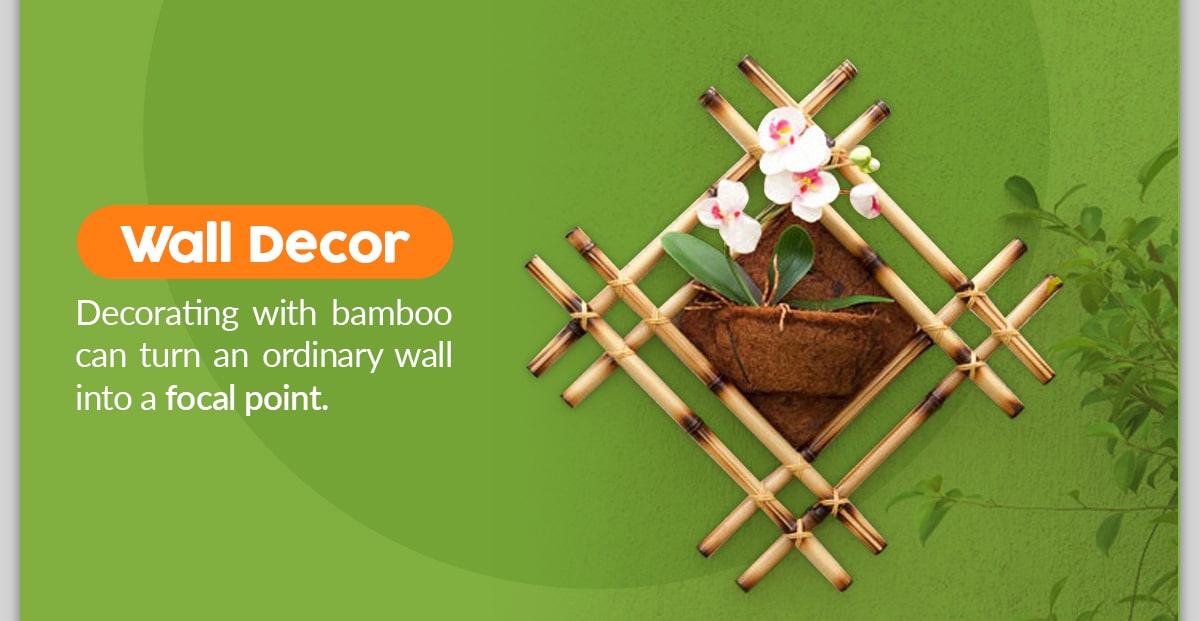
Everyone wants wall decor for their home that is unique and inspires good thoughts and feelings. Decorating with bamboo can turn an ordinary wall into a focal point. You may want to consider bamboo designs for your office, as well. Research indicates that incorporating natural elements into your office space can have a positive effect on your mental health and attitude toward your job. Other studies indicate that incorporating color into your environment is good for mood.
To create some natural and colorful bamboo decor, place bamboo poles on old sheets, tarps or newspaper outside. Apply a thin coat of paint all over the bamboo and let dry overnight. Use masking tape or painter’s tape to tape off designs on each pole. You can also use the tape to create thicker or wider stripes of your favorite colors. Apply more paint to the surface, remove the tape once the paint dries and repeat until you create a design you like.
For a more natural look, you can create designs with natural bamboo. For some natural color variation, try mixing in some natural black bamboo poles. Phyllostachys nigra is an unusual bamboo species that produces a dark brown, speckly appearance. Whatever look you go for, you can use picture wire or hooks to hang those funky bamboo pieces on your walls.
3. Headboard
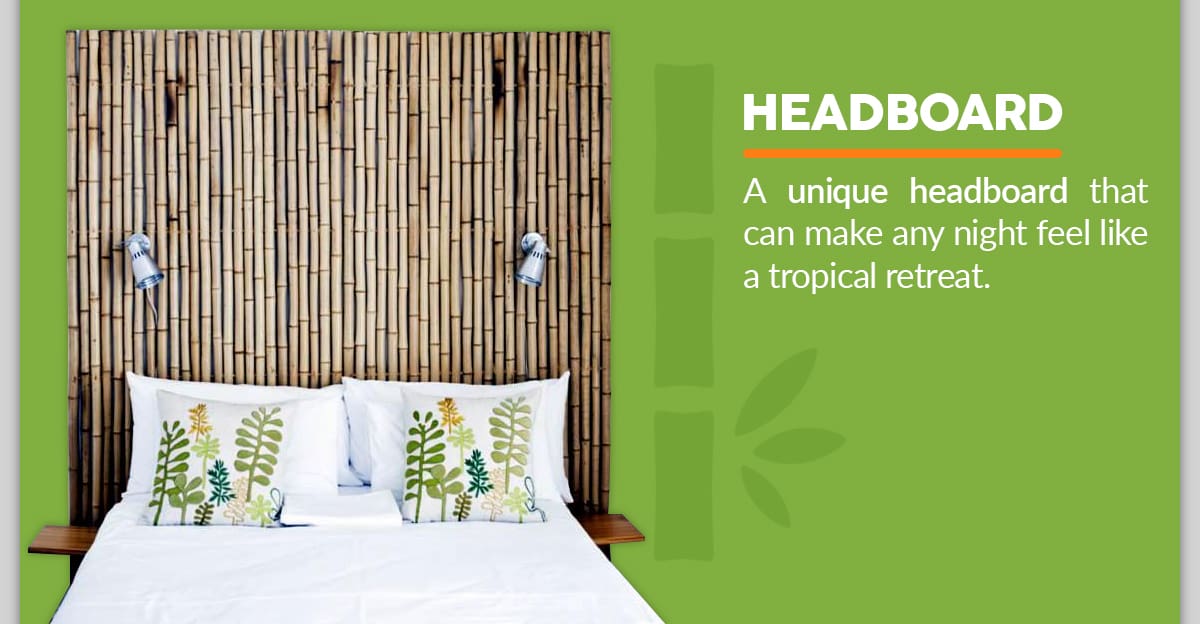
To bring a tropical element into your bedroom decor, create a bamboo headboard for your bed. Determine how many bamboo poles you will need to span the width of your bed. If you have a queen size bed that is 60 inches wide, then you should plan for a width of about 64 inches since most headboards are just a bit wider than your mattress.
Lay your poles out in a single layer to create the design you want and cut them to your desired length. You can make sure they are all the same height for a uniform look, or you can vary them for a more organic appearance. Generally, most headboards are around 3 feet tall. Many headboards are higher in the middle and lower on the sides, so you may want to try this design for your bamboo poles.
Once your poles are laid out in your desired design, take 2-foot pieces of twine, rope or string and tie two bamboo poles together a third of the way down from the top and a third of the way from the bottom. Continue this pattern across the poles, and then attach the headboard to the wall by the twine using wall hooks. Now you have a unique headboard that can make any night feel like a tropical retreat.
4. Coat Rack
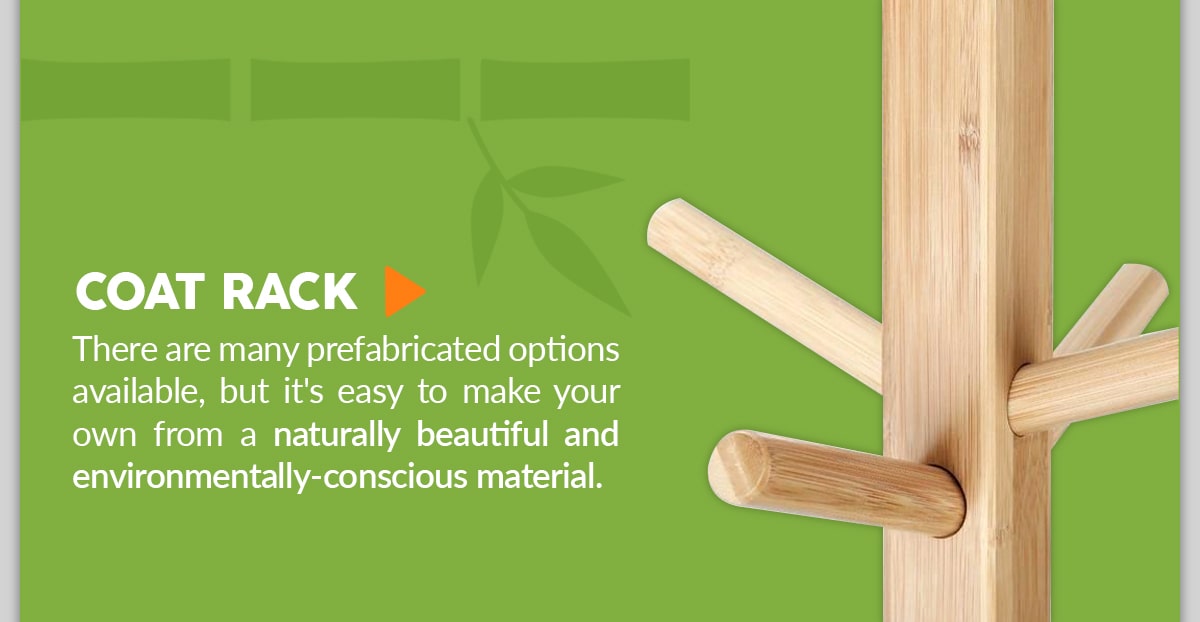
A great addition to any entryway or mudroom is a multi-function coat rack. Of course, there are many prefabricated options available, but it’s easy to make your own from a naturally beautiful and environmentally-conscious material. This is an easy bamboo project you can complete in less than an hour and with minimal tools.
All you need is a drill, some twine or cord, and four 5-foot bamboo poles. If you want, you can paint part or all of the bamboo poles or leave them natural. First, mark a spot about a foot and a half from one end of each pole that will form the bottom of your coat rack. You will then drill a small hole straight through each pole where you marked so that they each have an opening at the same height.
Then, hold the bamboo poles in a bundle. About a foot and a half down from the top, wrap the cord around the bundle several times until about 4 inches of the bundle is covered in cord and then tie it off. Next, stand your poles up and splay them out so that they form a teepee shape of your desired size. All that is left to do then is to run additional cord through the holes you drilled and tie it off so that the poles cannot spread too far at the bottom and collapse your new coat rack.
5. Coffee Table
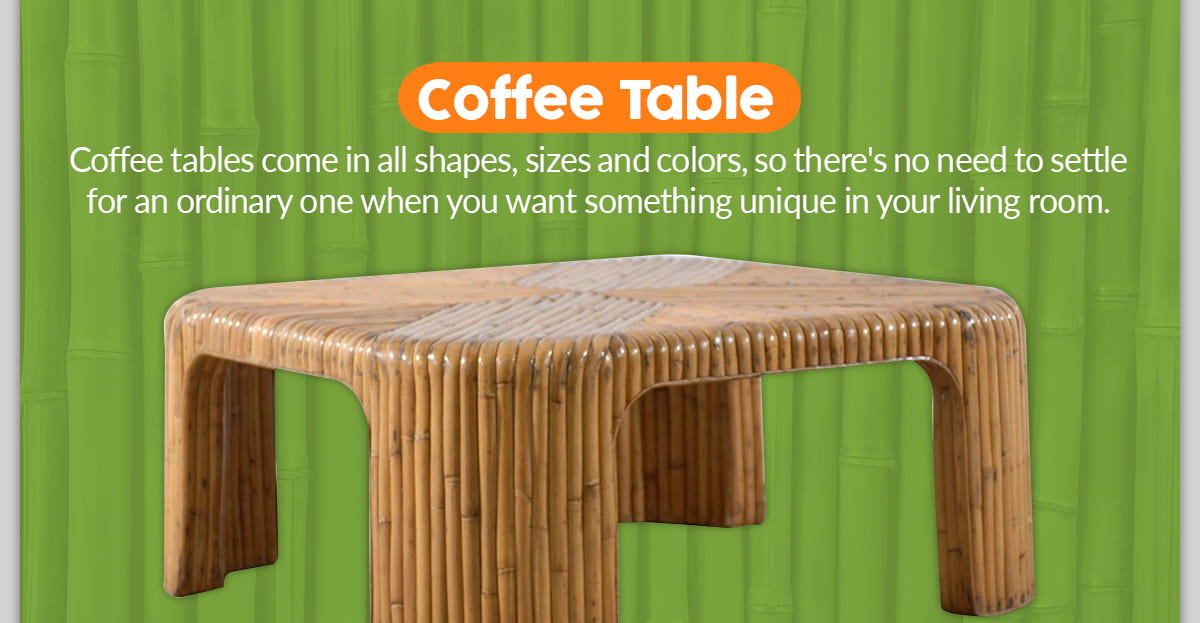
Coffee tables come in all shapes, sizes and colors, so there’s no need to settle for an ordinary one when you want something unique in your living room. For a beautifully airy and organic coffee table you can make yourself, all you need is a drill, some bamboo poles, twine and a piece of glass. For the four legs, make sure you use bamboo with a wide diameter so it’s strong. The cross supports can be made from smaller poles.
One great thing about making your own coffee table is that you can choose the perfect size for your space. Once you’ve determined the dimensions for your table, cut the bamboo poles to size. For the cross pieces, leave an extra centimeter or two. Now, drill two holes 90 degrees apart on each of your table legs and insert the cross pieces into the holes. You should now have a rectangle of cross pieces connected to four vertical legs.
When the pieces are all in place, secure them with glue. To enhance the appearance, wrap these joints tightly with twine or rope. You may also want to lacquer the bamboo for shine and preservation. The final step is to add the glass top. You want the glass to extend about 3 inches beyond the table legs.
6. Garden Edging
Edging helps define the edges of flower beds, walkways and more. Common materials for garden edging include wood, brick, stone and plastic. For a more interesting look, you can use bamboo as the border to separate features in your lawn. Bamboo is naturally durable, but you can make it stand up to the elements even better if you treat it with a sealant before installing it outside.
This is an especially easy project if you purchase bamboo borders. This border comes pre-assembled with short, asymmetrical poles that are capped and attached to each other with heavy-duty galvanized steel wire. This garden edging is flexible so you can place it along any straight or curved perimeter. If it’s too long, just cut the wire to remove as many poles as you need to. You can give extra support to the bamboo border with rebar or wooden stakes.
For a more DIY route, you can use any size bamboo poles to create garden edging. Start by measuring the length of the area where you want to put the border and divide this length by the width of your poles to know how many pieces you need. If you want each piece to have a closed node at the top, you will need to order extra poles. Use the leftover pieces that are open at the top for another fun project. Use round pressure-treated hardwood stakes to plant your bamboo in the ground.
7. Planters
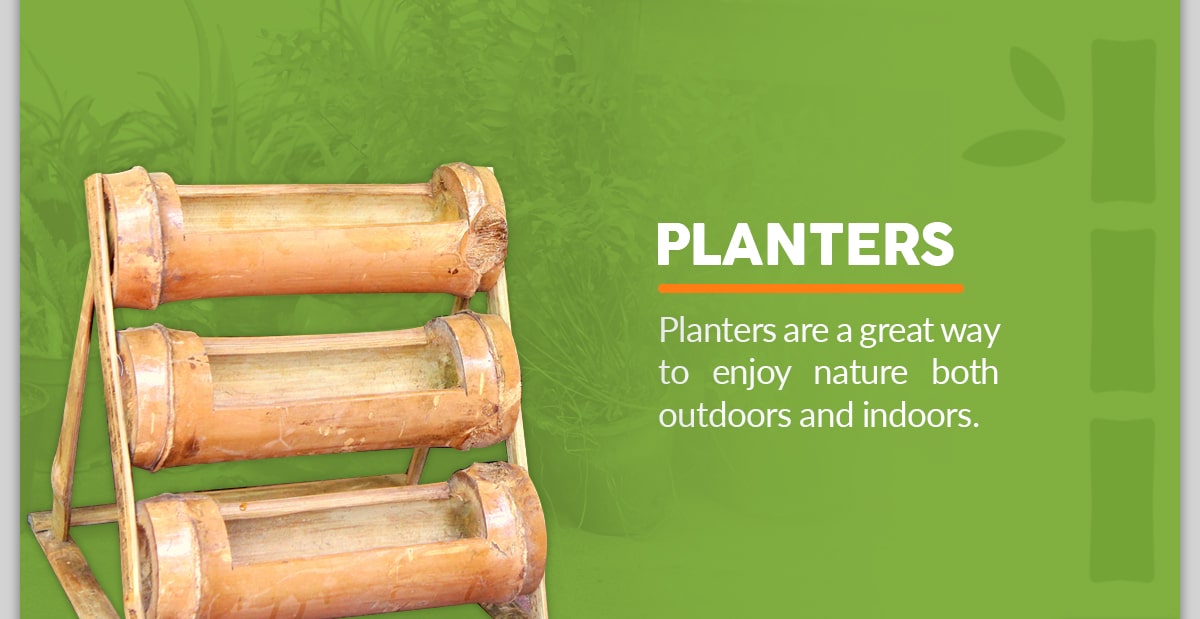
Planters are a great way to enjoy nature both outdoors and indoors. You can make your own durable bamboo planters that you can hang in your home or yard. Start with a bamboo pole that is fairly big around. Remember that bamboo is hollow except where the nodes are. To make bamboo planters, you will cut out a section with a node at one end. Where you cut into the internode will depend on how deep you want your bamboo planter to be.
Then, drill a small hole into the node at the bottom of the planter. This allows for drainage when you water your plants or when they collect rain. If you plan to set your planter on a surface, then you’re already done. If you want to hang your planter, you also need to drill a hole on either side of the planter so you can connect a wire. To hang the planters vertically, then drill these holes near the top of the planter.
To hang the planters diagonally so that the plants hang down from the planter, drill the holes for the wire near the bottom of the planter and an additional hole near the top. Now, you can thread the wire through to make a T shape. You can hang several planters like this in a vertical configuration. Now, plant your favorite greenery or flowers in your planters and enjoy watching them grow.
8. Plant Trellis
Creeping or vining plants, such as peas, beans and tomatoes or flowers like clematis and morning glories, need a trellis as a supporting framework so they can spread and thrive. Vinyl lattices can diminish the natural appearance of your garden. A great way to support your plants while preserving the natural beauty of your garden is by constructing a bamboo trellis.
First, determine the height and width necessary for your plant and cut some bamboo poles to fit those dimensions. Lay the vertical pieces on the ground, either straight up and down or diagonal with the tops angled in. Then, space the horizontal pieces evenly across the vertical pieces to create a grid. You should consider what type of plant you’re constructing the trellis for and what spacing would best suit the size and growth pattern of the vines.
With your grid arranged, all that’s left to do is cut some pieces of twine and tie them tightly around all the intersections of the poles to hold the trellis together. Now your trellis is ready to be placed upright and either planted firmly into the ground with pressure-treated hardwood end stakes or leaned against the exterior of your house or another supporting structure.
9. Fencing
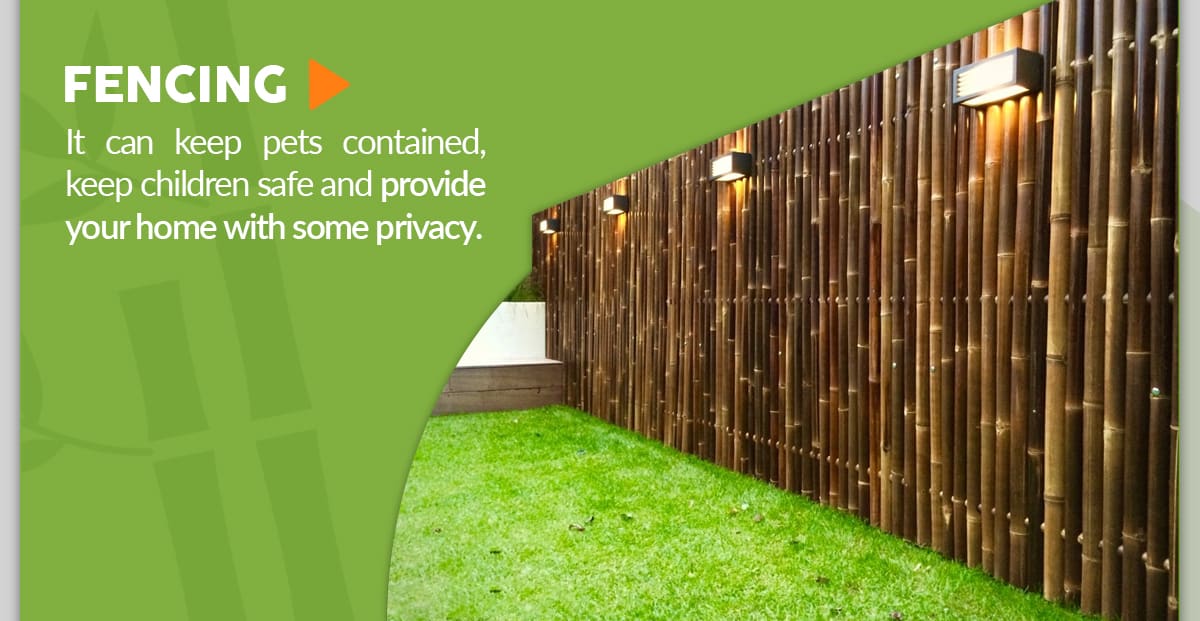
Fencing has many practical uses. It can keep pets contained, keep children safe and provide your home with some privacy. Unfortunately, some fencing, while it may be functional, is unsightly. Incorporating bamboo into your fencing is an excellent way of turning your backyard into a private haven of natural beauty. You can select from different varieties of bamboo or even stain the bamboo fencing to achieve your desired look.
Bamboo fencing should be affixed to an existing wooden or chainlink fence for support. You can use drywall screws, coated deck screws or zip ties to attach the bamboo poles to the framework. Purchase bamboo fencing, which comes in rolls. When rolled out, these fencing sections span a long distance.
Each bamboo pole is connected to the next with galvanized wire. To install your fencing panels on a wooden fence, predrill holes and use deck screws to attach the bamboo to the fence at spaced-out intervals. On a chainlink fence, use zip ties around the wire to attach the fencing. If your fence is atop soil, use treated two-by-four boards at the base of your bamboo to create a barrier between it and the soil.
10. Tiki Bar

Many beautiful homes are accented with a bar that serves both as a focal point for social gatherings and a retreat once those gatherings have adjourned for the night. A classic theme, such as Tiki, can help to make your bar both memorable and inviting. The classic Tiki bar would not be complete without a facing of bamboo to emphasize the island-feel.
If you’re building a bar from scratch, then choose the dimensions and materials you want to suit your needs. Whether you’re putting the front on a new bar or on a pre-existing bar you want to enhance, creating a bamboo finish is as simple as either screwing, nailing, or gluing bamboo slats to the existing surface. For an especially easy install, there is ready-made bamboo paneling that you can install as complete units, saving time and effort in installing individual slats. Just remember to measure twice so you can cut once.
If your bar is outside, then you may also want to add a roof to complete your Tiki bar. Make holes at all four corners of the counter and use glue to secure four bamboo poles in the holes. You can construct a frame for the roof out of bamboo and use natural or artificial thatch to complete the tropical look.
11. Outdoor Shower
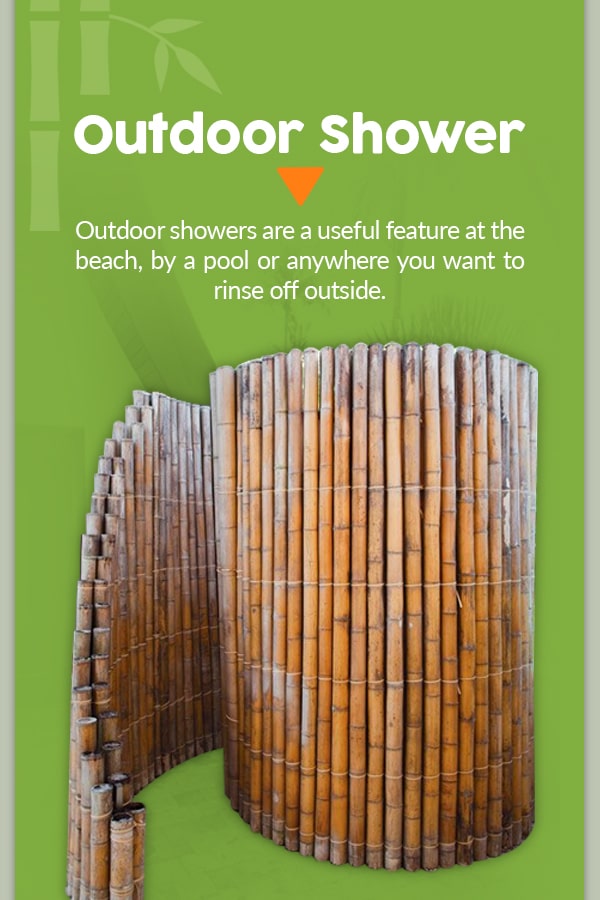
Outdoor showers are a useful feature at the beach, by a pool or anywhere you want to rinse off outside. You can elevate a purely functional outdoor shower to an attractive feature by renovating it with some bamboo. Sealed bamboo is water-resistant, so it’s the perfect material for an outdoor shower.
If you don’t already have an enclosure for your outdoor shower, you can make one. Set up vertical poles and then use two-by-four boards placed horizontally to make a framework. Your framework can be rectangular or circular, depending on your preference. Now, you can wrap the frame in bamboo, leaving an opening for stepping in and out of the shower.
The easiest way to do this is to use bamboo fencing so the bamboo poles are already attached to one another. Use screws or zip ties to attach the bamboo fencing to the framework of the shower. Be sure to apply sealant to the bamboo to make it more durable. Now you have an outdoor shower that is just as beautiful as it is useful.
12. Benches
Since bamboo is strong enough for load-bearing furniture, you can use it to construct a bench for the inside of your home or outside in your garden. This project is a good one for more ambitious creators since it’s a little more involved than many of the previous projects on this list. The materials needed for this project include bamboo poles, a saw, a power drill and strong wire. The size and number of bamboo poles you need will depend on your design for your bench.
The basic steps to making a backless bench are to create the surface for sitting and four sturdy legs. The legs of your bench can be made from lumber or can be large-diameter bamboo poles, cut short. The surface for sitting should be made by connecting a series of bamboo poles together. You can tie them the traditional way using twine, or you can drill holes and use wire to connect them.
Add a cross support on each end of the bench by drilling two holes, spaced vertically, in each of the four legs. Insert one end of a thinner bamboo pole into the top hole on one leg and the lower hole on the adjacent leg and secure in place with glue. Repeat until you have an X shape on each end of your bench.
Use Forever Bamboo for All Your High-Quality Bamboo Needs
At Forever Bamboo, we’re passionate about bamboo and its many uses. You can source all of your high-quality bamboo and other tropical-themed materials from Forever Bamboo. To learn more, browse through our many product offerings online, or contact us today!

